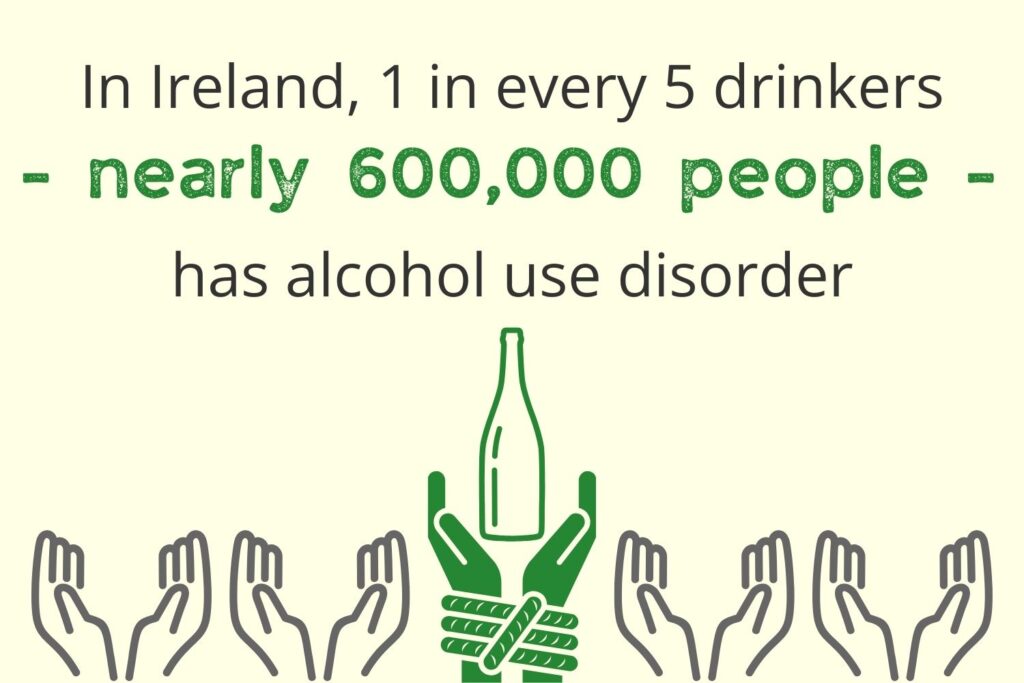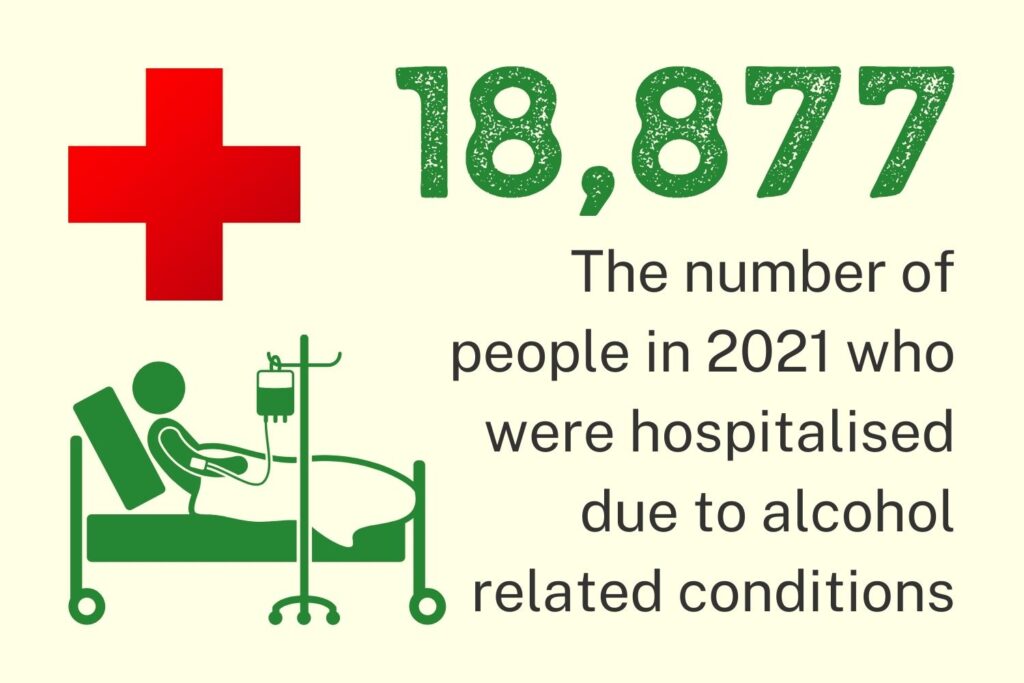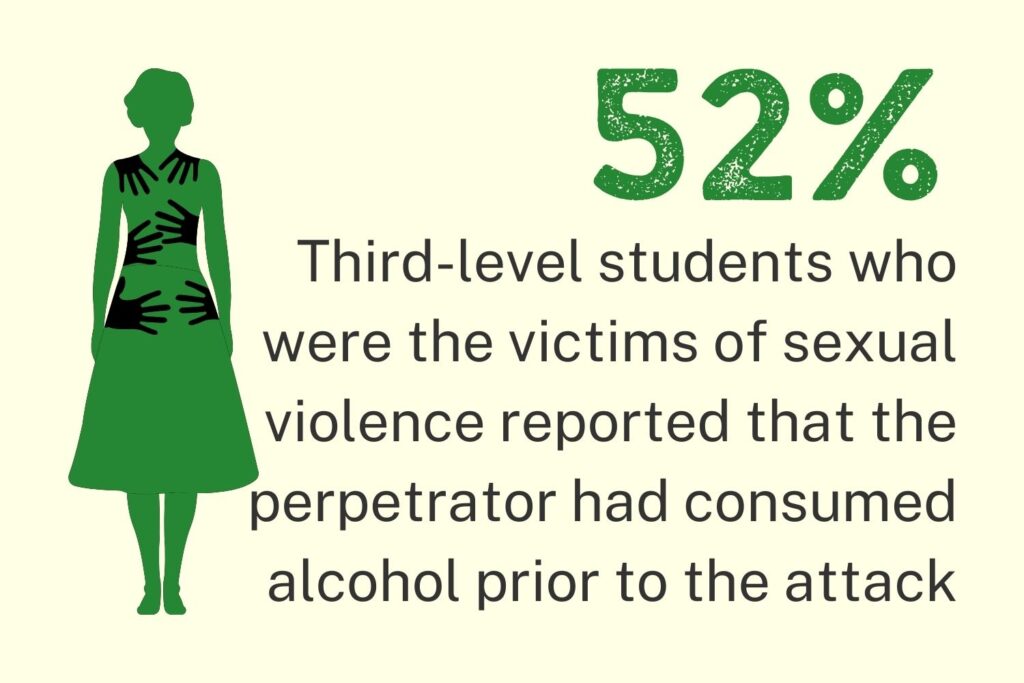The recently published Health Research Board report – Alcohol: availability, affordability, related harm, and policy in Ireland, pulls on a wide variety of data sources, which, when brought together paint a picture of a society that is hugely burdened due to the harm that alcohol causes across society from the cradle to the grave. This blog pulls out just some of the data around health harms for drinkers, health and social systems and children -the invisible victims of alcohol harm.
The statistics make for difficult but vital reading, in order that policy makers are not swayed by red herring arguments from the alcohol industry that Ireland’s relationship with alcohol is a healthy one that doesn’t need regulation. As the lost and disrupted lives that make up these chilling statistics demonstrate, Ireland has a long way to go in reducing harmful and hazardous alcohol use.
Alcohol use

Per capita alcohol use in Ireland in 2023 was 9.9 litres of pure alcohol per person aged 15 years and over, a 2.9% decrease from 2022. However, there are a growing number of abstainers from alcohol in Ireland. According to the HRB, when abstainers (1,281,000 according to the 2023 Healthy Ireland Survey) are excluded, alcohol consumption among drinkers aged 15 years and over increases to 14.1 litres of pure alcohol per person in 2023. This is considerably more than the Department of Health’s stated aim to reduce per capita alcohol consumption in Ireland to 9.1 litres per person.
Unfortunately, for those who are drinking, more than one-half were classified as hazardous drinkers. This was ascertained by using the WHO’s AUDIT-C screening tool and was more common among males (65.7%) than females (34.2%), particularly younger males.
Health harm from alcohol is caused not only by the amount of alcohol consumed, usually over long periods of time, but also patterns of drinking such as heavy and/or binge drinking.
Hazardous drinking can increase the risk of alcohol-related harms for the drinker – specifically the likelihood of poisoning, accidents, or falls – as well as alcohol-related conditions such as cancer and heart disease.
The HRB states that one in every five drinkers was classified as having AUD (alcohol use disorder). This equates to nearly 600,000 people. Again, this was more common among male drinkers (24.8%) than female drinkers (15.1%), and was highest among those aged 15–24 years (37.5%)
Harm to health

The Global Burden of Disease (GBD) study uses the measure of disability-adjusted life years (DALYs), which is a calculation of the years lost due to a disease or health condition.
It found that in Ireland, more than 62,000 years of full health were compromised due to alcohol use, with men in particular being more likely to lose years of healthy life (44,538 years) as well as those aged 15–49 years (28,418 years). The data points to the heavy toll that alcohol takes on young lives in Ireland.
Alcohol use disorder (AUD) and alcohol-related cancers accounted for the top causes of alcohol-attributable DALYs.
Alcohol-related hospitalisations is a good measure that highlights the considerable burden on the Irish health system and the substantial preventable loss of life that alcohol causes.
In 2021, the most recent stats available,18,877 people were hospitalised due to wholly alcohol-related conditions. The length of stay for alcohol-related conditions increased in 2021 and was almost double that of a non-alcohol-related condition (9.9 days compared with 5.7 days). In 2021, 5.2% of all inpatient bed days were alcohol-related, meaning that such illness accounted for 177,230 bed days.
Rates of hospital discharges due to alcohol-related liver disease in Ireland have steadily increased over time and 2021 saw the highest rate ever recorded, a 79.9% increase compared with 2002.
This data indicates that not only are more patients presenting for alcohol-related liver disease but that when they do, they are sicker than in 2002, requiring more complex treatment.
Treatment services
Given the very heavy burden on health services from people impacted by drinking alcohol, you would expect to see high numbers of people in treatment. Unfortunately, treatment services are woefully inadequate given the scale of the problem, as outlined above.
Worryingly, despite alcohol being Ireland’s largest substance use problem, the number of people receiving treatment for alcohol has decreased over time.
In 2022 there were 7,421 cases for alcohol treatment, down from 7,618 cases in 2015. The number of new cases (i.e. not known to have previously received treatment) also decreased during this time, from 3,553 cases in 2015 to 3,278 cases in 2022.
In 2022, 60.2% of cases receiving treatment for problem alcohol use were treated in outpatient facilities, 32.9% were treated in residential settings
Brief intervention was the most frequent intervention provided to cases with alcohol as the primary problem substance. Among those entering treatment in 2021, 2,912 cases received brief intervention treatment and 2,493 cases received individual counselling.
Mental health

Alcohol is a depressogen; it causes chemical changes in the brain and can lead to anger, depression, or anxiety. It also affects the brain by slowing down the processing of information, making it more difficult to make logical decisions. Alcohol use has long been linked with poor mental health, including both self-harm and suicide. Globally, suicide was the third leading alcohol-related cause of death among those aged 15–49 years according to the 2019 GBD study.
In Ireland, a study found alcohol was detected in the toxicology in 44% of suicides.
In 2020, there were 11,932 episodes of self-harm in Ireland recorded. One in every three self-harm presentations in 2020 (3,873; 33%) was alcohol related.
The use of alcohol when experiencing poor mental health can lead to an increased risk of developing alcohol dependence, and alcohol use worsens feelings of depression and anxiety. A study involving 1,983 participants examined individuals’ reported mental health as the restrictions associated with the pandemic eased. More than one-quarter (27.7%) of participants reported depression and anxiety symptoms, and moderate to heavy drinkers were among the most at risk of experiencing depression and anxiety compared with non-drinkers or occasional drinkers.
Harm to others

A 2020 study found that one-third (33.0%) of people surveyed reported having someone in their life – be it a family member, friend, co-worker, or someone else – who they considered to be a heavy drinker or drinks a lot on occasions, and 13.8% of these respondents reported that they were affected because of it.
Harm to family was the most common harm reported by all age groups with the exception of those aged 15–24 years, who were more likely to report being assaulted (12.6%) and being a passenger with a drunk driver (11.5%). Females aged 35–49 years were almost twice as likely as males in the same age group to report harm to family as a result of someone else’s drinking (16.1% of females compared with 8.7% of males). In addition, 4.3% of females aged 25–34 years reported financial harm as a result of others’ drinking; the comparable figure for males in the same age group was 3.1%. Elsewhere, among a sample of the population of Ireland, 51% of respondents reported experiencing harm due to stranger’s drinking in the previous 12 months.
A study in 2022 found that one quarter of an adult sample had grown up with a ‘problem drinker’ in the home.
Children

Children are impacted by alcohol in a number of ways, from prenatal exposure, to exposure to parental alcohol use and hazardous drinking in early teen years due to living in an alcogenic society.
FASD
Current global estimates are that almost 1 in every 10 pregnant women consumes alcohol during pregnancy and that there are 19.8 cases of FASD per 1,000 of the population in the WHO European region, but that the rate is substantially higher in Ireland (47.5 per 1,000 of the population) due to per capita alcohol use levels. Data from an Irish study, PRAMS, indicated that 75.9% of women reported pre-pregnancy alcohol use. Just under one-half (48.4%) indicated that they had received alcohol use advice during antenatal care and reports of alcohol use before pregnancy did not significantly increase the likelihood of receiving alcohol use advice. Alcohol use advice was less likely to be given to women who had previously given birth and to those with private health insurance. The study found that 59.8% of the women in the sample stopped drinking during pregnancy. More work is required to provide the information needed to prevent FASD and drinking in pregnancy.
Parental drinking
Evidence shows that children’s exposure to parental alcohol use, even non-dependent alcohol use, can lead to children initiating alcohol use earlier than their peers who are not exposed to parental drinking, as well as to harmful drinking patterns in adolescence. Children who witness their parents drinking, particularly if the parents’ drinking is motivated by stress or other negative reasons, are more likely to experience negative outcomes such as receiving less attention from their parent(s), less time spent doing homework with their parent(s), or being put to bed earlier or later than usual.
Despite the widespread prevalence of children (including adult children) living with PPAU, there are no specific supports available in Ireland for those affected. A study examining the experience of mental health professionals working with clients who have experienced PPAU found that 70% had not received PPAU-specific training, and that less than one-quarter (24%) of the mental health professionals routinely asked their clients about their experiences of PPAU. Interventions and programmes are most needed in order to reduce the impact of PPAU, and supports outside the family home should be accessible and available to children regardless of their parent’s own treatment.
Sexual violence

it is important to recognise that presenting statistics around alcohol use and victims of sexual assault is in no way blaming a victim for their alcohol use. Data from the sexual assault treatment units (SATUs) indicated that in 2022, when such information was recorded, 48.5% of the patients treated across the six SATU locations had consumed more than six standard drinks in the 24 hours prior to the incident.
Where such information was recorded, 21% of patients who attended a SATU reported being concerned that drugs (including alcohol) had been used by the perpetrator to facilitate the sexual assault. This represented an increase from 13% of patients in 2018.
Sexual violence in third-level settings is a relatively common occurrence, and the evidence indicates that alcohol and other drugs play a role in many such incidents.
Over two-thirds of students who had experienced sexual violence reported consuming alcohol before the incident occurred (68.5%).
Students who reported experiencing sexual violence were asked a further set of questions about the sexual violence and whether alcohol or drugs were being used by the other person prior to the incident. Alcohol was the most commonly reported substance used by the person who was responsible for the violence and was reported by 52% of the students who responded.
